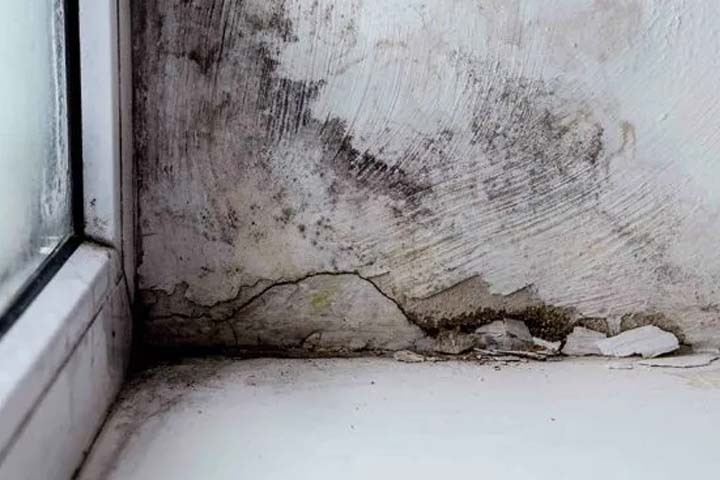The difference between damp and mould lies in their nature and impact. Damp refers to the presence of unwanted moisture in buildings, often resulting from leaks, condensation, or poor ventilation.
Mould, on the other hand, is a type of fungus that thrives in damp conditions, appearing as black, green, or white patches on walls, ceilings, and other surfaces.
Understanding this distinction is crucial for homeowners and tenants alike. While dampness can weaken structural integrity and lead to material decay, mould poses significant health risks, including respiratory issues and allergic reactions.
Understanding Damp
What Is Damp?
Dampness is the accumulation of moisture within building structures.
Condensation: Occurs when warm, moist air meets cold surfaces, leading to water droplets forming on walls and windows.
- Penetrating Damp: Caused by water seeping through external walls due to defects like cracks or faulty gutters.
- Rising Damp: Happens when groundwater rises through walls due to the absence or failure of a damp-proof course.
 Signs of Damp
Signs of Damp
Identifying damp early can prevent extensive damage.
- Peeling paint or wallpaper
- Discoloration or staining on walls and ceilings.
- Musty odors.
- Cold or damp walls.
Understanding Mould
What Is Mould?
Mould is a fungus that grows in moist environments. It reproduces through spores that can spread through the air, settling on surfaces and growing when conditions are favorable.
 Signs of Mould
Signs of Mould
Mould is often visible and can be identified by:
- Black, green, or white patches on walls, ceilings, or furniture.
- A strong, musty smell.
- Allergic reactions like sneezing, coughing, or skin irritation.
Damp vs Mould: A Comparative Overview
| Aspect | Damp | Mould |
|---|---|---|
| Definition | Presence of unwanted moisture in structures | Fungal growth in moist environments |
| Causes | Leaks, condensation, poor ventilation | Thrives in damp, humid conditions |
| Appearance | Stains, peeling paint, damp patches | Black, green, or white fuzzy patches |
| Health Impact | Can lead to mould growth | Causes respiratory issues, allergies |
| Prevention | Improve ventilation, fix leaks, use dehumidifiers | Control humidity, clean affected areas |
Health Risks Associated with Damp and Mould
Both damp and mould can have adverse health effects:
- Respiratory Issues: Exposure can lead to asthma, bronchitis, and other respiratory conditions.
- Allergic Reactions: Symptoms include sneezing, skin rashes, and red eyes.
- Weakened Immune System: Prolonged exposure can compromise immunity, especially in children and the elderly.
It’s essential to address these issues promptly to maintain a healthy living environment.
Prevention and Treatment
Preventing Damp
- Ventilation: Ensure rooms, especially kitchens and bathrooms, are well-ventilated.
- Insulation: Proper insulation can prevent condensation on walls and ceilings.
- Regular Maintenance: Check for leaks in roofs, pipes, and gutters regularly.
Treating Mould
- Cleaning: Use mould removal sprays or a mixture of vinegar and water to clean affected areas.
- Dehumidifiers: These devices reduce moisture levels, making conditions less favorable for mould growth.
- Professional Help: For extensive mould infestations, consider hiring specialists.
Government Schemes: ECO4 and Free Boiler Scheme
The UK government offers initiatives to help households combat damp and mould:
- ECO4 Scheme: Provides funding for energy-efficient home improvements, reducing the risk of damp.
- Free Boiler Scheme: Eligible households can receive a new boiler, ensuring efficient heating and reducing condensation.
For more information, visit the ECO4 Scheme and Free Boiler Scheme.Energy Saving Genie+2Energy Saving Genie+2Energy Saving Genie+2
FAQs
Can damp exist without mould?
Yes, damp can be present without visible mould. However, if not addressed, it creates conditions conducive to mould growth.
Is mould always visible?
No, mould can grow in hidden areas like behind wallpaper or under carpets. A musty smell often indicates its presence
How quickly can mould develop?
Mould can start growing within 24 to 48 hours in damp conditions.
Are there health risks associated with damp alone?
While damp itself doesn’t cause health issues, it can lead to mould growth, which poses health risks.
Can I remove mould myself?
For small areas, yes. Use protective gear and mould removal solutions. For extensive growth, seek professional help.
How can I prevent damp and mould in my home?
Ensure proper ventilation, fix leaks promptly, use dehumidifiers, and maintain consistent indoor temperatures.
Conclusion
Understanding the difference between damp and mould is vital for maintaining a healthy home. While damp refers to unwanted moisture, mould is a fungus that thrives in such conditions, posing health risks.
By ensuring proper ventilation, regular maintenance, and utilizing government schemes like the ECO4 and Free Boiler Scheme, homeowners can effectively combat these issues.


 Signs of Damp
Signs of Damp

